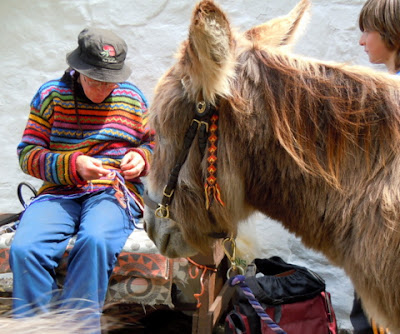 |
| Up-along, Down-along, the Clovelly main thoroughfare |
A visit to Clovelly located on the northern coast of Devon in England is like stepping back in time. Clinging to a cliff face that drops 400' in half a mile to the harbour below, Clovelly's cottages, chapels, craft shops, galleries, the Kingsley Museum, and the popular New Inn meander downhill along its precipitous cobbled High Street. The Clovelly main thoroughfare is called Up-Along and Down-Along by the locals.
Because of the street's gradient, cars are banned. Goods, and that includes visitor's luggage and everyday household requirements purchased by the locals, are lowered Down-Along and dragged Up-Along on custom made sledges.
For those unable to negotiate the perilous terrain ... no problem. A Landrover takes a back route to and from the village. Walkers though should be warned. Slip-resistant shoes on the Clovelly precipitous main street are a wise investment.
For a peek at hidden treasures when exploring this fishing enclave, one has only to take off along any one of the Clovelly side alleys. Like a well orchestrated extravaganza, artfully placed wooden benches coax passersby to stop awhile for spectacular views along the North Devon coast. Some of the Clovelly cottages are embellished with carved fruits and flowers from the Bavarian Alps adding an Oberammergau aspect to these quaint homes. In a tumble of blossom, trailing fuchsia and petunias nestle in hanging baskets among tall sprays of lavender.
 |
| Sue Kelly's donkeys |
No longer beasts of burden and in keeping with their dignity, their duties are now mainly tourist designated. Before the advent of the sledge, heavy loads comprising beer barrels, laundry and garbage bags were stacked on special pack saddles and carried to the top of the cliff by these stocky little animals. Today one of their more pleasureable pursuits is posing for photographs and standing in the sun on Down-Along, while their owner Sue Kelly weaves bright ribbons for their harnesses.
Festivals are heldthroughout the year in this fishing village and the Clovelly Herring Festival in November is one of the most popular. It's a grand event for foodies, with herring, kipper and bloaters on the menu. Shanty singing by “Shake a Leg” from Bideford, “Hanging Johnny” from Plymouth or Exmouth's “Shantymen” set feet a-tapping.
 |
| Fishing boat in the Clovelly harbour |
Posted by Anne Gordon on Wednesday, 27th July 2011
Photos copyright Anne Gordon
